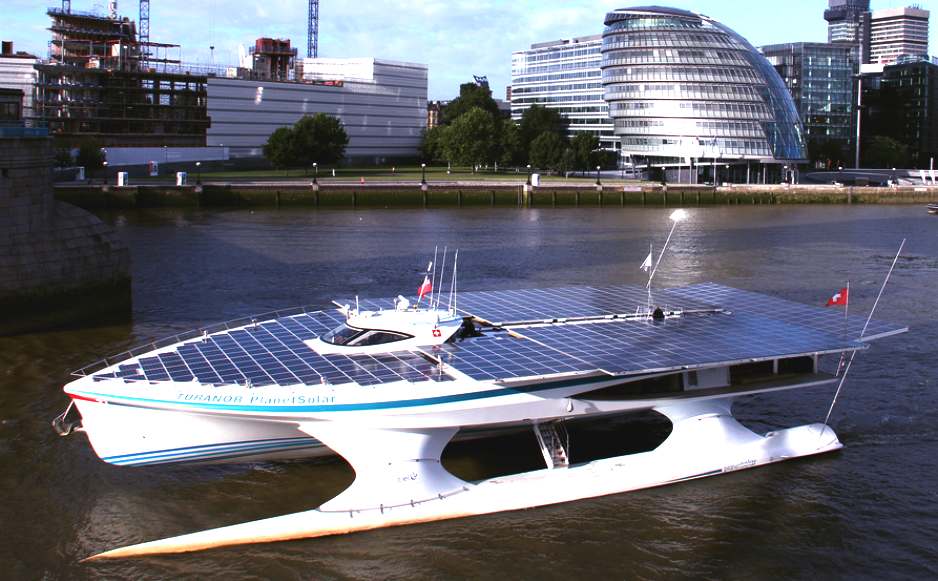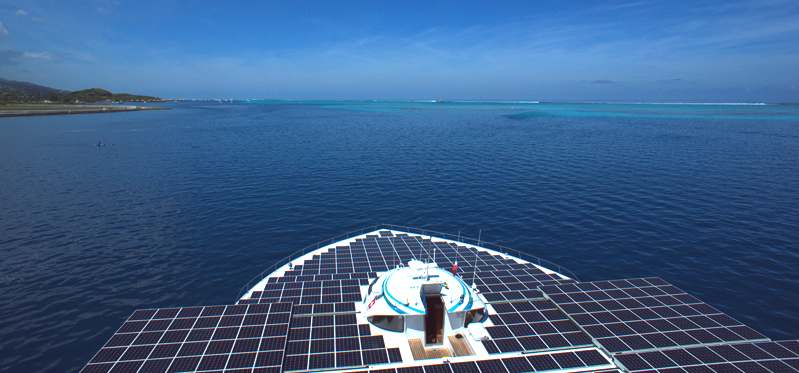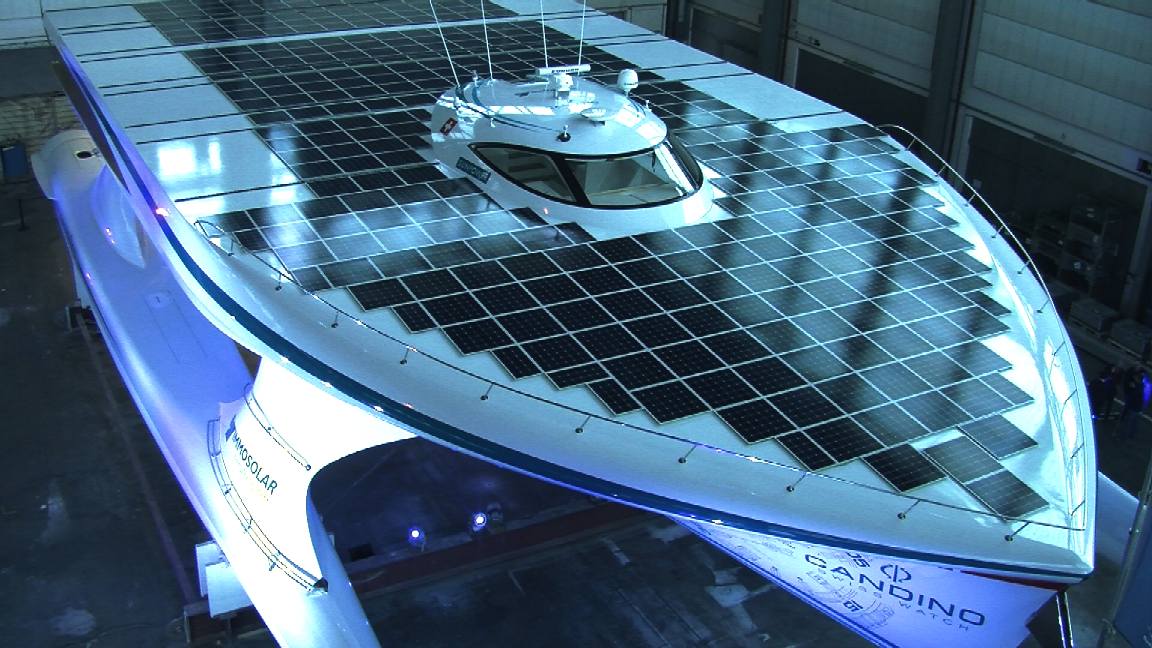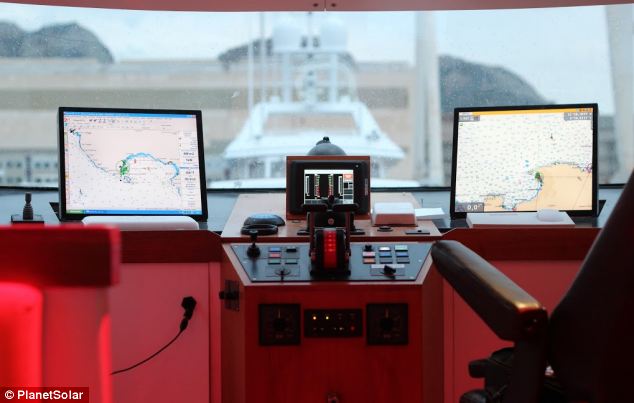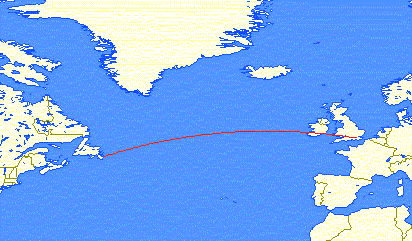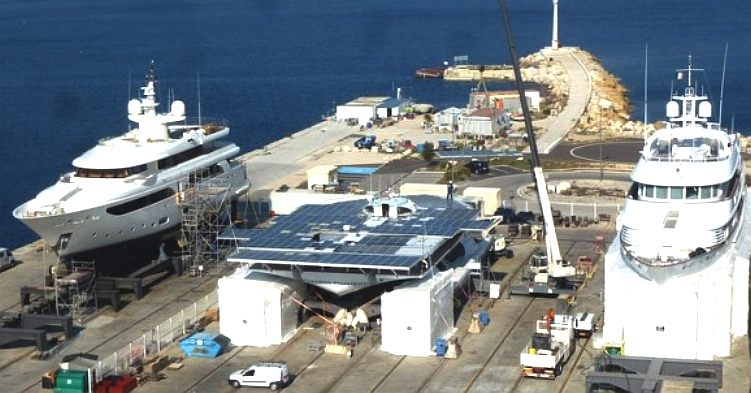|
PLANETSOLAR - VISITS CANARY WHARF, LONDON TOWN
|
|
|
Planetsolar travels along the River Thames past City of London council offices
The world's
largest SOLAR boat powered by 809 panels: Eco-friendly vessel breaks world record after crossing Atlantic in just 22 days - and it's completely silent
The world’s largest solar boat is making
London its final port of call on an epic voyage of scientific discovery along the Gulf stream.
Turanor Planetsolar cruising wings spread wide
WHARF.CO.UK
PlanetSolar, a Swiss boat which has just returned from an Atlantic crossing, will come trhough West India Dock Pierhead at 9.45am on Saturday morning.
The World's largest solar powered ship, and the first vessel of its kind to travel round the world, will then remain at South Quay until Tuesday afternoon.
PlanetSolar is 31 metres long and travels at an average speed of less than nine
kilometres an hour. It is covered in 500 square metres of solar panels.
The Turanor Planetsolar during construction in Australia
MOTOR BOAT & YACHTING 29 AUGUST 2013
The 115ft PlanetSolar Turanor will be berthed at Canary Wharf from Saturday to Monday 2 September, its first visit to the UK. The remarkable vessel made headlines in 2012 for completing the world's first circumnavigation on solar power alone.
It has spent the last four months in the Atlantic being used as a research platform by the University of Geneva. The PlanetSolar DeepWater expedition set out to take biological and physical measurements along the length of the Gulf Stream, the warm north Atlantic current that has a big influence on UK weather.
"Following the DeepWater expedition, there is now a wealth of physical, chemical, and biological data housed at the University of Geneva, and which is beginning to undergo exhaustive scientific scrutiny," Professor Martin Beniston said.
"Although the data has not been analysed yet, we have noticed some very interesting trends, especially with regards to the production of aerosols by sea sprays."
During its voyages, PlanetSolar travels at an average speed of 5
knots, with power coming from 512 square metres of solar panels.
It cost 15million EURO and was financed by a German entrepreneur.
Turanor Planetsolar enters port
Launched in Florida, its DeepWater expedition sought to collect a continuous series of physical and biological measurements along the Gulf Stream, both from the water and the atmosphere, using advanced instruments onboard.
Turanor Planetsolar just before taking the plunge again
Professor Beniston said: 'The MS Tûranor
PlanetSolar has positive benefits for scientific study and exploration, allowing for pollution-free research to be carried out in the vicinity of the boat.'
It was designed by Craig Loomes from
New Zealand after months of research into creating the optimum dimensions and design of the double-hulled vessel.
CALL SIGN HBY4444
Vessel's DetailsShip
Type: Pleasure
Craft Last Position Received 5 Sept 2013Area: English
Channel
COMMENT: FUTURE DEVELOPMENT
The latest British 'Bluefish' contender is somewhat longer at 43 meters (140 ft) yet considerably lighter with just 300 meters of solar panels giving more than twice the power to weight ratio of Planetsolar, which is what makes the second generation design economically viable. That will make the Bluefish platform the largest solar boat in the world, since it is also wider in the water - once it is built that is. The other key features of this advanced design are the deployment of solar energy harvesting devices (panels, etc) robotically and fully autonomous navigation control options for hydrographic and oceanographic duties. The fact the Planetsolar is being deployed in such manner is proof of concept - except that the Bluefish consortium are aiming to extend that concept into the realms of fully robotic automation - with SWASH hull technology to boost operating speeds considerably such that blue water cruising is expected to be around 7-10 knots with sprints of up to 18 knots.
You may notice that the reported speed of Planetsolar differs from one media article to another. The shortest points to cross the Atlantic are from the Canary Islands to the Caribbean, some 2500 miles and from St Johns, Newfoundland, to St Levan, Porthcurno, UK, some 2200 - 2500 miles covered in 22 days is equal to 4.16 - 4.73 knots average speed. Having studied the design we can say that this is about what one might expect from a catamaran hull (large canoe) like this if leaving with fully charged batteries and with good conditions - and it is an impressive performance.
With shipping accounting for 2.7% of the planet’s total carbon emissions (air travel creates less than 2%) and with emissions from shipping potentially doubling by 2050, finding cleaner propulsion methods for cargo ships is an urgent priority.
Sailing the Planetsolar requires special skills on the part of the captain. You need to plan well ahead, look at the weather reports and decide where you’ll get the most sunshine balanced against the least resistance from the tides.
Captain Gerard d’Aboville says they have not run out of power yet, so
yet more proof of concept.
LINKS
http://www.ypte.org.uk/blog/2013/09/06/ http://www.mby.com/news/535154/planetsolar-world-s-largest-solar-powered-boat-visits-london http://www.wharf.co.uk/2013/08/worlds-largest-solar-powered-s.html#more The worlds largest SOLAR boat breaks world record crossing Atlantic just 22 days http://www.nytimes.com/2013/06/25/science/solar-boat-harnessed-for-research.html New York Times solar boat harnessed for research http://au.businessinsider.com/oceanographic campaign to study the gulf stream http://www.planetsolar.org/follow-us/planetsolar-awards http://www.marinetraffic.com/ais/shipdetails.aspx?mmsi=269116000 http://www.ship-technology.com/projects/planetsolar/ Marine Traffic.com/ais/Planet Solar Rouen World tour solar powered boat planetsolar to beat- limate change http://www.theverge.com/2013/6/22/4454980/ms-turanor-planetsolar-solar-powered-boat-photo-essay http://www.wharf.co.uk/2013/09/pictures-planetsolar-docked-at.html http://www2.dupont.com/Photovoltaics/en_US/news_events/article20100406.html http://www2.dupont.com/Photovoltaics/en_US/index.html#.UiqEXNKsg6Y http://coatingsolutions.dupont.com/portal/ http://www.charterworld.com/news/arrival-planetsolar-york-city/aboard-planetsolar-reaching-new-york http://www.prweb.com/releases/2013/6/prweb10840938.htm http://www.marinetraffic.com/ais/default.aspx?centerx=1.068¢ery=49.4275&zoom=12
Design concept - Raphael Domjan - PROMOTIONAL TOUR 2012
English - Swiss - French - History - Links - Homecoming
The captain of a solar powered ship take on pirate whalers with a $Billion dollars riding on the conclusion.
Planetsolar during a refit in Monaco
|
|
|
This website is Copyright © 2013 Bluebird Marine Systems Ltd. The names Bluebird™, Bluefish™, Solar Navigator™, Utopia Tristar™ and the blue bird & fish in flight logos are trademarks. All other trademarks are hereby acknowledged. The color blue is a protected element of the marks.
|
|
